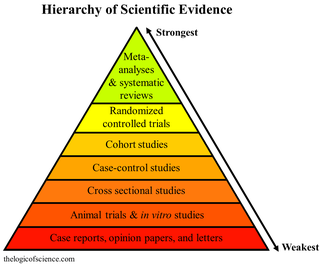Evidence-based medicine (EBM) is "the conscientious, explicit and judicious use of current best evidence in making decisions about the care of individual patients." The aim of EBM is to integrate the experience of the clinician, the values of the patient, and the best available scientific information to guide decision-making about clinical management. The term was originally used to describe an approach to teaching the practice of medicine and improving decisions by individual physicians about individual patients.

A randomized controlled trial is a form of scientific experiment used to control factors not under direct experimental control. Examples of RCTs are clinical trials that compare the effects of drugs, surgical techniques, medical devices, diagnostic procedures or other medical treatments.
Medical ethics is an applied branch of ethics which analyzes the practice of clinical medicine and related scientific research. Medical ethics is based on a set of values that professionals can refer to in the case of any confusion or conflict. These values include the respect for autonomy, non-maleficence, beneficence, and justice. Such tenets may allow doctors, care providers, and families to create a treatment plan and work towards the same common goal. It is important to note that these four values are not ranked in order of importance or relevance and that they all encompass values pertaining to medical ethics. However, a conflict may arise leading to the need for hierarchy in an ethical system, such that some moral elements overrule others with the purpose of applying the best moral judgement to a difficult medical situation. Medical ethics is particularly relevant in decisions regarding involuntary treatment and involuntary commitment.
A patient is any recipient of health care services that are performed by healthcare professionals. The patient is most often ill or injured and in need of treatment by a physician, nurse, optometrist, dentist, veterinarian, or other health care provider.
In academic publishing, a retraction is a mechanism by which a published paper in an academic journal is flagged for being seriously flawed to the extent that their results and conclusions can no longer be relied upon. Retracted articles are not removed from the published literature but marked as retracted. In some cases it may be necessary to remove an article from publication, such as when the article is clearly defamatory, violates personal privacy, is the subject of a court order, or might pose a serious health risk to the general public.
David Southall is a retired British paediatrician who specialised in international maternal and child hospital healthcare and in child protection. He worked in Bosnia and Herzegovina in 1993-1995, for which he received an OBE in 1999. In 1995 he set up the charity Maternal and Childhealth Advocacy International (MCAI), of which he remains a trustee as of 2023. His child protection work and research into Munchausen syndrome by proxy attracted controversy and led to conflict with the General Medical Council.
A clinical decision support system (CDSS) is a health information technology that provides clinicians, staff, patients, and other individuals with knowledge and person-specific information to help health and health care. CDSS encompasses a variety of tools to enhance decision-making in the clinical workflow. These tools include computerized alerts and reminders to care providers and patients, clinical guidelines, condition-specific order sets, focused patient data reports and summaries, documentation templates, diagnostic support, and contextually relevant reference information, among other tools. CDSSs constitute a major topic in artificial intelligence in medicine.
The Declaration of Helsinki is a set of ethical principles regarding human experimentation developed originally in 1964 for the medical community by the World Medical Association (WMA). It is widely regarded as the cornerstone document on human research ethics.

A systematic review is a scholarly synthesis of the evidence on a clearly presented topic using critical methods to identify, define and assess research on the topic. A systematic review extracts and interprets data from published studies on the topic, then analyzes, describes, critically appraises and summarizes interpretations into a refined evidence-based conclusion. For example, a systematic review of randomized controlled trials is a way of summarizing and implementing evidence-based medicine.
Therapeutic privilege refers to the decision of a healthcare practitioner to withhold information from a patient when there is a justified belief that disclosure may cause serious mental or physical harm to them. As of 2022, this defence is permissible in countries such as Australia, Canada, England, Netherlands and Wales as an exception to the standard consent process. Despite this, there are very limited cases in which therapeutic privilege has been upheld. This is mainly due to the complex ethical and legal ramifications in withholding information from a patient and how to define someone as being at sufficient risk to fall into this category wherein therapeutic privilege should prevail. Another challenge in enacting therapeutic privilege is the consideration of other professionals involved in patient care, such as where there is a multidisciplinary care team. However, in withholding information, there is also a denial of patient autonomy
Shared decision-making in medicine (SDM) is a process in which both the patient and physician contribute to the medical decision-making process and agree on treatment decisions. Health care providers explain treatments and alternatives to patients and help them choose the treatment option that best aligns with their preferences as well as their unique cultural and personal beliefs.
Decision aids are interventions or tools designed to facilitate shared decision making and patient participation in health care decisions.
David M. Eddy is an American physician, mathematician, and healthcare analyst who has done seminal work in mathematical modeling of diseases, clinical practice guidelines, and evidence-based medicine. Four highlights of his career have been summarized by the Institute of Medicine of the National Academy of Sciences: "more than 25 years ago, Eddy wrote the seminal paper on the role of guidelines in medical decision-making, the first Markov model applied to clinical problems, and the original criteria for coverage decisions; he was the first to use and publish the term 'evidence-based'."

Choosing Wisely is a United States-based health educational campaign, led by the ABIM Foundation, about unnecessary health care.

Health information on the Internet refers to all health-related information communicated through or available on the Internet.
The GRADE approach is a method of assessing the certainty in evidence and the strength of recommendations in health care. It provides a structured and transparent evaluation of the importance of outcomes of alternative management strategies, acknowledgment of patients and the public values and preferences, and comprehensive criteria for downgrading and upgrading certainty in evidence. It has important implications for those summarizing evidence for systematic reviews, health technology assessments, and clinical practice guidelines as well as other decision makers.
In global health, priority-setting is a term used for the process and strategy of deciding which health interventions to carry out. Priority-setting can be conducted at the disease level, the overall strategy level, research level, or other levels.
Explainable AI (XAI), often overlapping with Interpretable AI, or Explainable Machine Learning (XML), either refers to an AI system over which it is possible for humans to retain intellectual oversight, or to the methods to achieve this. The main focus is usually on the reasoning behind the decisions or predictions made by the AI which are made more understandable and transparent. XAI counters the "black box" tendency of machine learning, where even the AI's designers cannot explain why it arrived at a specific decision.
ReSPECT stands for Recommended Summary Plan for Emergency Care and Treatment. It is an emergency care and treatment plan (ECTP) used in parts of the United Kingdom, in which personalized recommendations for future emergency clinical care and treatment are created through discussion between health care professionals and a person. These recommendations are then documented on a ReSPECT form.
In the domain of hospital medicine, interdisciplinary bedside rounds are a collaborative approach to patient care that involves the participation of the bedside nurse, primary provider, and the patient. They are often joined by family members and allied health professionals such as the patient's pharmacist and case manager.



